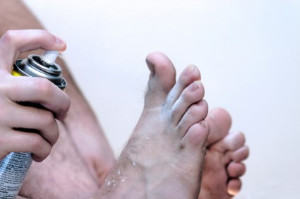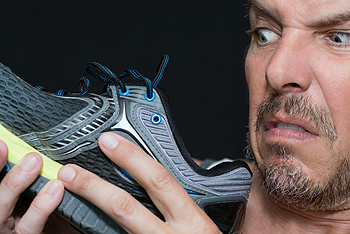April 2020
Do I Have Athlete's Foot?
 The area of the feet that athlete's foot impacts is generally between the toes, and on the sole of the foot. It is considered to be a fungal infection, and can be extremely contagious. This type of fungus lives and thrives in warm and moist environments, and can typically be found in public swimming pools, shower room floors, and surrounding areas. Patients who have experienced athlete’s foot often notice a red and itchy rash, and in severe cases, blisters may develop as well. Relief may be found in mild cases when an antifungal powder or cream is applied. Additionally, it is beneficial to wear appropriate shoes while in these types of places, which can help to prevent the spreading of athlete’s foot. If you are afflicted with this condition, please consult with a podiatrist who can prescribe the correct medication for you.
The area of the feet that athlete's foot impacts is generally between the toes, and on the sole of the foot. It is considered to be a fungal infection, and can be extremely contagious. This type of fungus lives and thrives in warm and moist environments, and can typically be found in public swimming pools, shower room floors, and surrounding areas. Patients who have experienced athlete’s foot often notice a red and itchy rash, and in severe cases, blisters may develop as well. Relief may be found in mild cases when an antifungal powder or cream is applied. Additionally, it is beneficial to wear appropriate shoes while in these types of places, which can help to prevent the spreading of athlete’s foot. If you are afflicted with this condition, please consult with a podiatrist who can prescribe the correct medication for you.
Athlete’s Foot
Athlete’s foot is often an uncomfortable condition to experience. Thankfully, podiatrists specialize in treating athlete’s foot and offer the best treatment options. If you have any questions about athlete’s foot, consult with Dr. Lee R. Stein from Lake Shore Foot & Ankle, PC. Our doctor will assess your condition and provide you with quality treatment.
What Is Athlete’s Foot?
Tinea pedis, more commonly known as athlete’s foot, is a non-serious and common fungal infection of the foot. Athlete’s foot is contagious and can be contracted by touching someone who has it or infected surfaces. The most common places contaminated by it are public showers, locker rooms, and swimming pools. Once contracted, it grows on feet that are left inside moist, dark, and warm shoes and socks.
Prevention
The most effective ways to prevent athlete’s foot include:
- Thoroughly washing and drying feet
- Avoid going barefoot in locker rooms and public showers
- Using shower shoes in public showers
- Wearing socks that allow the feet to breathe
- Changing socks and shoes frequently if you sweat a lot
Symptoms
Athlete’s foot initially occurs as a rash between the toes. However, if left undiagnosed, it can spread to the sides and bottom of the feet, toenails, and if touched by hand, the hands themselves. Symptoms include:
- Redness
- Burning
- Itching
- Scaly and peeling skin
Diagnosis and Treatment
Diagnosis is quick and easy. Skin samples will be taken and either viewed under a microscope or sent to a lab for testing. Sometimes, a podiatrist can diagnose it based on simply looking at it. Once confirmed, treatment options include oral and topical antifungal medications.
If you have any questions, please feel free to contact one of our offices located in Chicago, Highland Park, and Uptown, IL . We offer the newest diagnostic and treatment technologies for all your foot care needs.
Why Do My Feet Sweat?
 Plantar hyperhidrosis is defined as excessive sweating of the feet. This is typically an uncomfortable condition, and it can cause difficulty in completing daily activities. The feet may emit an unpleasant odor, making many patients embarrassed to have this condition. This ailment can develop for a variety of reasons. These may include genetic factors, menopause, or possibly from having a thyroid disorder. Additionally, it can develop from taking specific medications that may include antidepressants. If you have plantar hyperhidrosis, it is strongly advised that you seek the counsel of a podiatrist who can properly guide you toward beginning the correct treatment techniques.
Plantar hyperhidrosis is defined as excessive sweating of the feet. This is typically an uncomfortable condition, and it can cause difficulty in completing daily activities. The feet may emit an unpleasant odor, making many patients embarrassed to have this condition. This ailment can develop for a variety of reasons. These may include genetic factors, menopause, or possibly from having a thyroid disorder. Additionally, it can develop from taking specific medications that may include antidepressants. If you have plantar hyperhidrosis, it is strongly advised that you seek the counsel of a podiatrist who can properly guide you toward beginning the correct treatment techniques.
If you are suffering from hyperhidrosis contact Dr. Lee R. Stein of Lake Shore Foot & Ankle, PC. Our doctor can provide the care you need to attend to all of your foot and ankle needs.
Hyperhidrosis of the Feet
Hyperhidrosis is a rare disorder that can cause people to have excessive sweating of their feet. This can usually occur all on its own without rigorous activity involved. People who suffer from hyperhidrosis may also experience sweaty palms.
Although it is said that sweating is a healthy process meant to cool down the body temperature and to maintain a proper internal temperature, hyperhidrosis may prove to be a huge hindrance on a person’s everyday life.
Plantar hyperhidrosis is considered to be the main form of hyperhidrosis. Secondary hyperhidrosis can refer to sweating that occurs in areas other than the feet or hands and armpits. Often this may be a sign of it being related to another medical condition such as menopause, hyperthyroidism and even Parkinson’s disease.
In order to alleviate this condition, it is important to see your doctor so that they may prescribe the necessary medications so that you can begin to live a normal life again. If this is left untreated, it is said that it will persist throughout an individual’s life.
A last resort approach would be surgery, but it is best to speak with your doctor to find out what may be the best treatment for you.
If you have any questions please feel free to contact one of our offices located in Chicago, Highland Park, and Uptown, IL . We offer the newest diagnostic and treatment technologies for all your foot and ankle needs.
Are You Suffering From Ingrown Toenails?
What is Gout?
 A large amount of uric acid in the body may lead to a condition that is commonly known as gout. This ailment often produces severe pain and discomfort, and typically affects the big toe. Patients who are afflicted with gout may notice the pain is so debilitating, it may cause an inability to walk. Additional symptoms may include redness, swelling, and some patients may have a fever. Gout is caused by factors that can include family history, and from eating foods that have elevated purine levels. This can lead to a build-up of uric acid, which may cause sharp pains between the joints in the big toe. These types of foods can consist of shellfish, red meat, and drinks that have a high sugar content. Mild relief may be found when the affected foot is elevated, and this may help to diminish a portion of the swelling as well. If you have developed gout, it is strongly advised that you consult with a podiatrist who can help you to find comfort, and suggest methods to possibly prevent this ailment from occurring in the future.
A large amount of uric acid in the body may lead to a condition that is commonly known as gout. This ailment often produces severe pain and discomfort, and typically affects the big toe. Patients who are afflicted with gout may notice the pain is so debilitating, it may cause an inability to walk. Additional symptoms may include redness, swelling, and some patients may have a fever. Gout is caused by factors that can include family history, and from eating foods that have elevated purine levels. This can lead to a build-up of uric acid, which may cause sharp pains between the joints in the big toe. These types of foods can consist of shellfish, red meat, and drinks that have a high sugar content. Mild relief may be found when the affected foot is elevated, and this may help to diminish a portion of the swelling as well. If you have developed gout, it is strongly advised that you consult with a podiatrist who can help you to find comfort, and suggest methods to possibly prevent this ailment from occurring in the future.
Gout is a painful condition that can be treated. If you are seeking treatment, contact Dr. Lee R. Stein from Lake Shore Foot & Ankle, PC. Our doctor will treat your foot and ankle needs.
What Is Gout?
Gout is a form of arthritis that is characterized by sudden, severe attacks of pain, redness, and tenderness in the joints. The condition usually affects the joint at the base of the big toe. A gout attack can occur at any random time, such as the middle of the night while you are asleep.
Symptoms
- Intense Joint Pain - Usually around the large joint of your big toe, and it most severe within the first four to twelve hours
- Lingering Discomfort - Joint discomfort may last from a few days to a few weeks
- Inflammation and Redness -Affected joints may become swollen, tender, warm and red
- Limited Range of Motion - May experience a decrease in joint mobility
Risk Factors
- Genetics - If family members have gout, you’re more likely to have it
- Medications - Diuretic medications can raise uric acid levels
- Gender/Age - Gout is more common in men until the age of 60. It is believed that estrogen protects women until that point
- Diet - Eating red meat and shellfish increases your risk
- Alcohol - Having more than two alcoholic drinks per day increases your risk
- Obesity - Obese people are at a higher risk for gout
Prior to visiting your podiatrist to receive treatment for gout, there are a few things you should do beforehand. If you have gout you should write down your symptoms--including when they started and how often you experience them, important medical information you may have, and any questions you may have. Writing down these three things will help your podiatrist in assessing your specific situation so that he or she may provide the best route of treatment for you.
If you have any questions, please feel free to contact one of our offices located in Chicago, Highland Park, and Uptown, IL . We offer the newest diagnostic and treatment technologies for all your foot care needs.
Blog Archives
- April 2025
- March 2025
- February 2025
- January 2025
- December 2024
- November 2024
- October 2024
- September 2024
- August 2024
- July 2024
- June 2024
- May 2024
- April 2024
- March 2024
- February 2024
- January 2024
- December 2023
- November 2023
- October 2023
- September 2023
- August 2023
- July 2023
- June 2023
- May 2023
- April 2023
- March 2023
- February 2023
- January 2023
- December 2022
- November 2022
- October 2022
- September 2022
- August 2022
- July 2022
- June 2022
- May 2022
- April 2022
- March 2022
- February 2022
- January 2022
- December 2021
- November 2021
- October 2021
- September 2021
- August 2021
- July 2021
- June 2021
- May 2021
- April 2021
- March 2021
- February 2021
- January 2021
- December 2020
- November 2020
- October 2020
- September 2020
- August 2020
- July 2020
- June 2020
- May 2020
- April 2020
- March 2020
- February 2020
- January 2020
- December 2019
- November 2019
- October 2019
- September 2019
- August 2019
- July 2019
- June 2019
- May 2019
- April 2019
- March 2019
- February 2019
- January 2019
- December 2018
- November 2018
- October 2018
- September 2018
- August 2018
- July 2018








